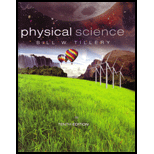
Physical Science
10th Edition
ISBN: 9780073513898
Author: Bill Tillery
Publisher: MCGRAW-HILL HIGHER EDUCATION
expand_more
expand_more
format_list_bulleted
Concept explainers
Question
Chapter 13, Problem 1QFT
To determine
To explain: How a radioactive material is different from a non-radioactive material.
Expert Solution & Answer
Want to see the full answer?
Check out a sample textbook solution
Students have asked these similar questions
Example
Two charges, one with +10 μC of charge, and
another with - 7.0 μC of charge are placed in
line with each other and held at a fixed distance
of 0.45 m. Where can you put a 3rd charge of +5
μC, so that the net force on the 3rd charge is
zero?
*
Coulomb's Law Example
Three charges are positioned as seen below. Charge
1 is +2.0 μC and charge 2 is +8.0μC, and charge 3 is -
6.0MC.
What is the magnitude and the direction of the force
on charge 2 due to charges 1 and 3?
93
kq92
F
==
2
r13 = 0.090m
91
r12 = 0.12m
92
Coulomb's Constant: k = 8.99x10+9 Nm²/C²
✓
Make sure to draw a Free Body Diagram as well
Chapter 13 Solutions
Physical Science
Ch. 13 - Prob. 1ACCh. 13 - Prob. 2ACCh. 13 - Prob. 3ACCh. 13 - Prob. 4ACCh. 13 - Prob. 5ACCh. 13 - Prob. 6ACCh. 13 - Prob. 7ACCh. 13 - Prob. 8ACCh. 13 - Prob. 9ACCh. 13 - Prob. 10AC
Ch. 13 - Prob. 11ACCh. 13 - Prob. 12ACCh. 13 - Prob. 13ACCh. 13 - Prob. 14ACCh. 13 - Prob. 15ACCh. 13 - Prob. 16ACCh. 13 - Prob. 17ACCh. 13 - Prob. 18ACCh. 13 - Prob. 19ACCh. 13 - Prob. 20ACCh. 13 - Prob. 21ACCh. 13 - Prob. 22ACCh. 13 - Prob. 23ACCh. 13 - Prob. 24ACCh. 13 - Prob. 25ACCh. 13 - Prob. 26ACCh. 13 - Prob. 27ACCh. 13 - Prob. 28ACCh. 13 - Prob. 29ACCh. 13 - Prob. 30ACCh. 13 - Prob. 31ACCh. 13 - Prob. 32ACCh. 13 - Prob. 33ACCh. 13 - Prob. 34ACCh. 13 - Prob. 35ACCh. 13 - Prob. 36ACCh. 13 - Prob. 37ACCh. 13 - Prob. 38ACCh. 13 - Prob. 39ACCh. 13 - Prob. 40ACCh. 13 - Prob. 41ACCh. 13 - Prob. 42ACCh. 13 - Prob. 43ACCh. 13 - Prob. 44ACCh. 13 - Prob. 45ACCh. 13 - Prob. 46ACCh. 13 - Prob. 1QFTCh. 13 - Prob. 2QFTCh. 13 - Prob. 3QFTCh. 13 - Prob. 4QFTCh. 13 -
5. What is a half-life? Give an example of the...Ch. 13 - Prob. 6QFTCh. 13 - Prob. 7QFTCh. 13 -
8. What is meant by background radiation? What is...Ch. 13 - Prob. 9QFTCh. 13 - What is a mass defect? How is it related to the...Ch. 13 - Prob. 11QFTCh. 13 - Prob. 1FFACh. 13 - Prob. 2FFACh. 13 -
3. Make up a feasible explanation for why some...Ch. 13 - Prob. 5FFACh. 13 - Prob. 7FFACh. 13 - Prob. 1PEBCh. 13 - Prob. 2PEBCh. 13 -
3. Predict if the nuclei in exercise 1 are...Ch. 13 - Prob. 4PEBCh. 13 - Prob. 5PEBCh. 13 -
6. If the half-life of cesium–137 is 30 years,...
Knowledge Booster
Learn more about
Need a deep-dive on the concept behind this application? Look no further. Learn more about this topic, physics and related others by exploring similar questions and additional content below.Similar questions
- RT = 4.7E-30 18V IT = 2.3E-3A+ 12 38Ω ли 56Ω ли r5 27Ω ли r3 28Ω r4 > 75Ω r6 600 0.343V 75.8A Now figure out how much current in going through the r4 resistor. |4 = unit And then use that current to find the voltage drop across the r resistor. V4 = unitarrow_forward7 Find the volume inside the cone z² = x²+y², above the (x, y) plane, and between the spheres x²+y²+z² = 1 and x² + y²+z² = 4. Hint: use spherical polar coordinates.arrow_forwardганм Two long, straight wires are oriented perpendicular to the page, as shown in the figure(Figure 1). The current in one wire is I₁ = 3.0 A, pointing into the page, and the current in the other wire is 12 4.0 A, pointing out of the page. = Find the magnitude and direction of the net magnetic field at point P. Express your answer using two significant figures. VO ΜΕ ΑΣΦ ? Figure P 5.0 cm 5.0 cm ₁ = 3.0 A 12 = 4.0 A B: μΤ You have already submitted this answer. Enter a new answer. No credit lost. Try again. Submit Previous Answers Request Answer 1 of 1 Part B X Express your answer using two significant figures. ΜΕ ΑΣΦ 0 = 0 ? below the dashed line to the right P You have already submitted this answer. Enter a new answer. No credit lost. Try again.arrow_forward
arrow_back_ios
SEE MORE QUESTIONS
arrow_forward_ios
Recommended textbooks for you
 University Physics Volume 3PhysicsISBN:9781938168185Author:William Moebs, Jeff SannyPublisher:OpenStax
University Physics Volume 3PhysicsISBN:9781938168185Author:William Moebs, Jeff SannyPublisher:OpenStax An Introduction to Physical SciencePhysicsISBN:9781305079137Author:James Shipman, Jerry D. Wilson, Charles A. Higgins, Omar TorresPublisher:Cengage Learning
An Introduction to Physical SciencePhysicsISBN:9781305079137Author:James Shipman, Jerry D. Wilson, Charles A. Higgins, Omar TorresPublisher:Cengage Learning College PhysicsPhysicsISBN:9781285737027Author:Raymond A. Serway, Chris VuillePublisher:Cengage Learning
College PhysicsPhysicsISBN:9781285737027Author:Raymond A. Serway, Chris VuillePublisher:Cengage Learning Principles of Physics: A Calculus-Based TextPhysicsISBN:9781133104261Author:Raymond A. Serway, John W. JewettPublisher:Cengage Learning
Principles of Physics: A Calculus-Based TextPhysicsISBN:9781133104261Author:Raymond A. Serway, John W. JewettPublisher:Cengage Learning
 College PhysicsPhysicsISBN:9781305952300Author:Raymond A. Serway, Chris VuillePublisher:Cengage Learning
College PhysicsPhysicsISBN:9781305952300Author:Raymond A. Serway, Chris VuillePublisher:Cengage Learning

University Physics Volume 3
Physics
ISBN:9781938168185
Author:William Moebs, Jeff Sanny
Publisher:OpenStax

An Introduction to Physical Science
Physics
ISBN:9781305079137
Author:James Shipman, Jerry D. Wilson, Charles A. Higgins, Omar Torres
Publisher:Cengage Learning

College Physics
Physics
ISBN:9781285737027
Author:Raymond A. Serway, Chris Vuille
Publisher:Cengage Learning

Principles of Physics: A Calculus-Based Text
Physics
ISBN:9781133104261
Author:Raymond A. Serway, John W. Jewett
Publisher:Cengage Learning


College Physics
Physics
ISBN:9781305952300
Author:Raymond A. Serway, Chris Vuille
Publisher:Cengage Learning